Polar bears sleep in snow shelters called “daybeds” after digging the snow. These beds are their shelter areas, where they rest. They also sleep on the ice and like to take short naps throughout the day. Furthermore, they sleep in various positions, including lying down, curled up, or stretched out.
If you are looking for the sleeping patterns of polar bears and wondering how they sleep, this article is for you. Let’s discuss the insights and find out why polar bears sleep a lot and what their favorite places are to sleep. Just read the article to trace the footprints of this amazing topic!
Where Do Polar Bears Sleep?
Whenever or wherever polar bears feel tired, they sleep. Mostly, they are sleeping and resting when they are not hunting. Polar bears sleep on land, snow, and ice. Where they sleep is dependent on the availability of suitable resting spots. For example, they sleep in snow drifts or rocky areas in the summer.
Polar Bears International organization found that polar bears in zoos like to choose a comfortable and dry spot. They chose a place with good visibility. Their daybeds are approximately 0.5 meters deep and 1.5 meters wide.
Dens of Polar Bears
Polar bears may also create earthen pits and dens to rest. They find natural shelters or excavate temporary dens to sleep in. In winter, they become so warm that their den temperature rises to 40 degrees Fahrenheit.
Polar bears can dig dens within 3 to 7 days. Interestingly, they also use blocks of ice as pillows in the winter. Polar bears stay in these shelters for many months. Gravel ridges or pits in the sand are also their favorite places to get regular sleep.
Here are a few safe areas where polar bears have been making dens for decades:
- Kongsøya Island in eastern Svalbard
- Neighboring islands of Svenskøya
- Hopen Island towards the south
- Norwegian Polar Institute
- Glen Liston of the University of Colorado
- Franz Josef Land
- Barents Sea
Due to various challenges, their dens’ preferred areas are changing day by day!
Fun Fact Time
According to the survey report of SeaWorld organization, polar bears spend 87 percent of their total time resting and sleeping from July to December in the James Bay region of Canada!
Where Do Polar Bear Cubs Sleep?
According to the research of the Polar Bears International organization, polar bear cubs sleep with their mothers. They sleep in shallow pits. These pits are different from dens or duns. These are more shallow and temporary. Their mothers dug the snow to create these pits. And, their cubs sleep on their bellies or paws.
How Do Polar Bears Sleep?
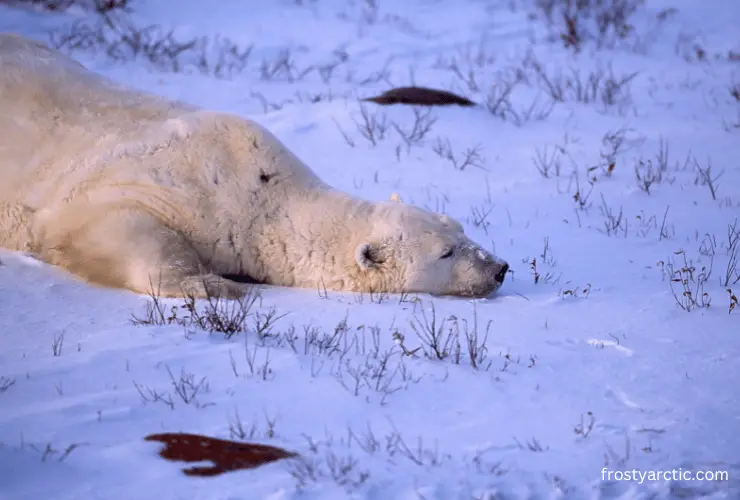
Polar bears sleep just like humans. These bears are masters at curling up and digging a pit, not for others, but for themselves. They dig shallow pits, show their backs to the wind, and sleep in comfort. Most of the time, they sleep on their bellies.
Here is another question that pops up in my mind: Do polar bears use pillows? They don’t use pillows. However, one of their outstretched paws does the work of a pillow. Their paws allow them to pile snow around their bodies.
In this way, they get extra insulation. Mostly, polar bears cover their noses with their paws to get extra warmth. Sometimes, they get rest while floating on ice floes in the water by lying down on their sides or stomachs. It’s fun watching sleeping polar bears curl up into a ball in their habitat!
How Long Do Polar Bears Sleep?
According to the study by the World Wildlife Organization, we found the following information about how long polar bears sleep:
“Polar bears sleep for 8 to 9 hours per day. Apart from regular sleep patterns, they also take naps in order to save their energy.”
Researchers from the Polar Bears International organization state that polar bears do not follow any specific sleep schedule like humans. They can sleep for a few minutes to several hours at a time. The researchers further found that polar bears sleep more during the daytime and less at night.
However, it’s hard to know whether polar bears sleep best in the daytime or at night in the summer. All because there are 24 hours of sunlight in the summertime in the Arctic. They often take short naps of one or two hours after having a good meal.
Why Do Polar Bears Sleep So Much?
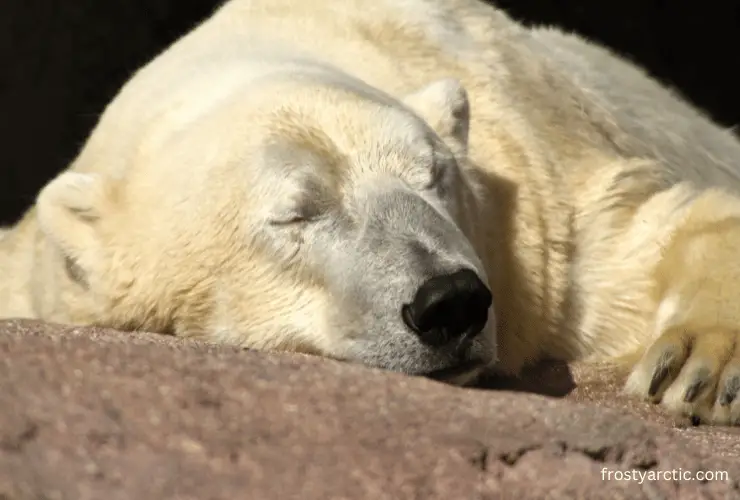
Let’s discuss a few reasons why they sleep more.
1. Conserving Energy
According to the research, a wildlife biologist and an associate professor, Tom Smith, said:
“Polar bears’ entire lifetime and their existence are based on two activities – sleeping and hunting. When we see polar bears every year in the land of Hudson Bay near Churchill, Manitoba, they wait for ice and seals for several months. During their waiting period, they sleep on willows, which are basically shrubs that are found in the tundra. They sleep and conserve their energy until the seal’s time comes and they start hunting again.”
2. Thermoregulation
As you know, the Arctic climate is extremely cold, and polar bears rely on their thick layer of blubber to keep themselves warm. That’s why they sleep more. Sleeping helps them conserve heat and prevent unnecessary heat loss during colder weather.
3. Hunting Patterns
Polar bears love to hunt seals, even though their entire lives revolve around them. Seals are most active in the early morning and late evening. So, sleeping during the day aligns with the seal’s behavior. As a result, their sleeping patterns increase the chances of a successful hunt when they are active.
4. Digestion
Polar bears need time to digest their food after consuming a large meal, like other animals and humans. Sleeping is one of the best activities for polar bears because it digests their food better than any other activity. In fact, sleeping allocates energy toward digestion. That’s why polar bears sleep more because they eat more and need more sleep to digest food.
5. Limited Food Supply
Food availability is limited or seasonal in many parts of the Arctic. This is another reason why polar bears sleep so much. They reduce their activity levels to cope with times of food scarcity.
6. Long Days of Darkness
In the Arctic winter, periods of extended darkness lead to a disruption in circadian rhythms. The lack of natural light hues force the bears to sleep, instead of doing other activities. Hence, polar bears sleep more during these months of winter.
7. Social Behavior
Polar bears are aggressive animals. Not just this, but they are solitary animals too. Their interactions with other bears, animals, and even humans can sometimes lead to aggression. Thus, sleeping helps them reduce the chances of conflicts between individuals.
Polar bears sleep more and more because they are born like this. They sleep because they like to sleep more.
Are Polar Bears Nocturnal, Crepuscular, Or Diurnal?
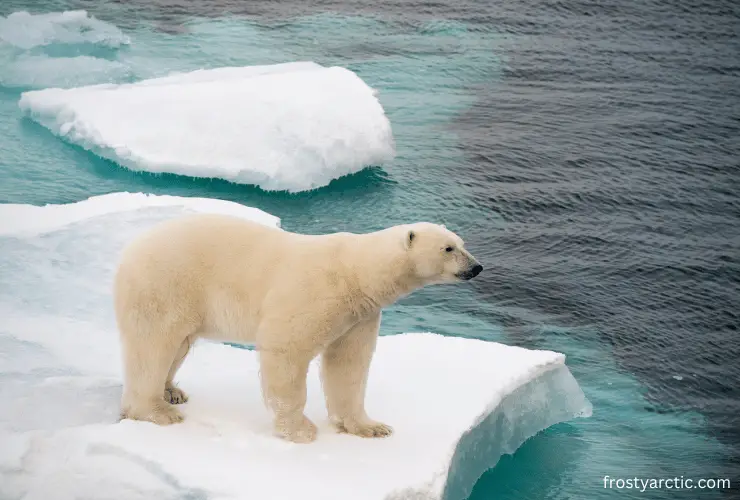
There is a lot of debate on this topic among various experts. However, many votes and viewpoints are in favor of crepuscular. It means polar bears are most active during the twilight hours of dawn and dusk.
So, polar bears are crepuscular. But, they also engage in diurnal and nocturnal behavior, rarely. There are many factors that cause polar bears to shift their sleep patterns. Let’s consider a few of them in the following section.
What Causes Polar Bears to Shift Their Sleep Patterns?
Here are a few reasons why polar bears shift their sleep patterns:
1. Threatened Feelings
We know that polar bears are apex predators. They only feel threatened by humans and other polar bears. So, polar bears change their sleep patterns for their own well-being. That’s why they become nocturnal in order to avoid the activities of humans and other bears.
2. Seasonal Factors
Scientists and wildlife researchers also believe that seasonal factors also affect the sleeping patterns of polar bears. Many polar bears, especially mummy polar bears, need to consume a lot of food. They prepare their bodies for hibernation and food scarcity.
What if they are unable to sustain more food in their regular activity cycles? These polar bears change their sleeping patterns to get food when it’s available at any other time. Then, they hunt at night and sleep in the daytime.
3. Climate Change
How can we forget to mention the main cause of the shifting sleep patterns of polar bears? Climate change is the primary reason why polar bears shift their rest times. For example, Arctic ice is melting more and more every year due to climate change.
The traditional prey of polar bears is decreasing rapidly. This is the reason polar bears are finding other food supplies. And, they are shifting their day and night duties for the purpose of finding new food sources.
Do Polar Bears Sleep For 6 Months?
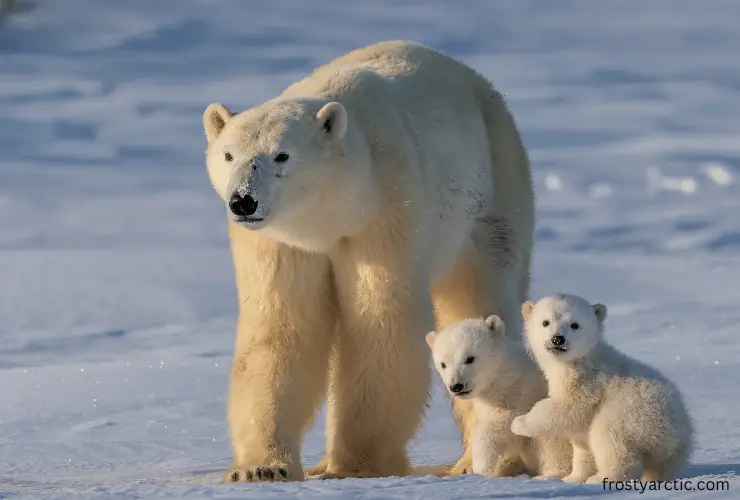
Polar bears do not exactly sleep for 6 months straight. But, they do enter a state called “walking hibernation” during the winter months. They do not hibernate like other bear species and female polar bears. In fact, if we talk about the hibernation period of female polar bears, they also do not sleep for 6 months straight.
Female polar bears hibernate for 2 to 3 months only. Scientists called the hibernation stage of polar bears “latherga sleep“. According to the report, polar bears become lethargic and sleep for more than 100 minutes. Do you know polar bears can snore?
Snoring means they sleep and wake up many times during their sleep, as humans do. It’s a normal thing for polar bears. In fact, it’s a part of their hibernation state. This state means they are only 25 percent active when they are sleeping or hibernating. They get restful nights sleep when they are snoring.
Frequently Asked Questions
Do polar bears sleep on trees?
No, polar bears do not sleep on trees. As we have discussed in a previous article, polar bears cannot climb trees. So, the answer is definitely no. We mean to say, How would they sleep on trees if they couldn’t climb or reach up there?
Do polar bears really sleep all winter?
The Alaska Department of Fish and Game reported that female polar bears hibernate during the winter season. But, they do not sleep the whole winter. They just hibernate for a few months or weeks, and then they come out of hibernation. When female polar bears hibernate, they do not eat or drink anything. They also do not urinate or defecate at all, or they rarely do this.
What do you think polar bears dream about?
It is difficult to know for sure what polar bears dream about. However, it is reasonable if we assume that their dreams are related to their daily experiences and instincts. Polar bears are intelligent animals with complex behaviors and emotions. So, their dreams could involve activities like hunting, foraging for food, interacting with other animals, or exploring their environment.
Can I sleep with a polar bear?
Absolutely not! You cannot sleep with a polar bear. These beasts look like cuddly creatures, but they are not meant for cuddling and sleeping with. Sleeping with a polar bear is extremely dangerous and not recommended under any circumstances. All because these animals are unpredictable and extremely aggressive.
Do polar bears sleep in caves?
No! Polar bears do not sleep in caves. However, certain occasions arrive when they sleep in caves in order to get shelter. Most often, female polar bears seek shelter in caves in order to hibernate. Caves give warmth to these pregnant polar bears during the winter season.
Where do polar bears like to sleep best?
Polar bears do like to sleep best in their cozy day beds. This shelter provides them comfort, safety, and protection from cold and wind. Additionally, polar bears sleep on ice floes if they are stable and can support their body weight. Their choice of sleeping location is primarily influenced by the need to conserve warmth and stay safe.
Conclusion
Last, but not least, polar bears sleep anywhere and at any time. This result shows that polar bears have a dynamic nature. They are wild animals, and every corner of Alaska and the Arctic region is their homeland, where they sleep and live with ease.
Whether it’s a blizzard or a shore, they start napping there. They can easily sleep in zero-degree Arctic temperatures without creating any fuss. Sometimes, nasty storms and extremely harsh weather force them to seek shelter somewhere else—not in dens!
So, this was a story about polar bears’ sleepless nights and days. I hope you like reading. Stay tuned to learn more about these fascinating animals. If you have any questions, you can ask them in the comments section.

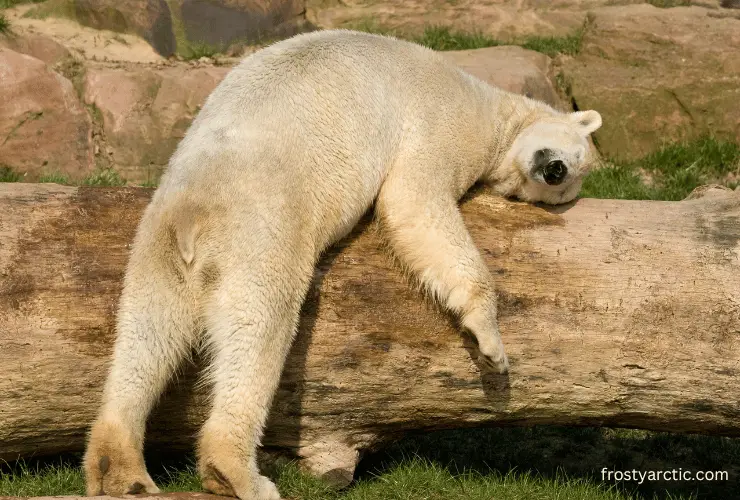

1 thought on “Where And How Do Polar Bears Sleep?”